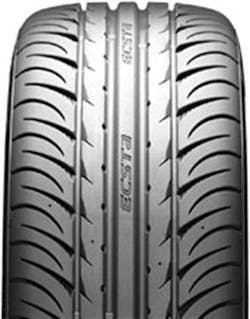The ultra-high performance (UHP) market is proliferating at an incredibly fast rate. We now see a number of categories within the UHP market, as ultra-high performance tires are refined and developed for very specific customer bases. According to Kumho Tire U.S.A. Inc.'s Frank Secondary, senior development engineer, about 50% of the UHP market is currently comprised of the UHP all-season type.
Compounds
While the typical street enthusiast tends to generalize tire compounds as being either "hard" or "soft" (high durometer/hard representing tires that don't offer optimum dry grip but may last longer; and soft/low durometer tires that offer better traction but may wear faster), this terminology is really far too broad. The information that proves more accurate refers to the characteristics that the compound offers within certain temperature ranges.
For example, the percentage of styrene (plastic) that's contained in the compound mix. As the styrene content increases, grip can increase over a wider temperature range. Instead of viewing a compound as either soft or hard, we need to know its resilience characteristics. A "soft" compound that provides a "dead" resilience may provide more grip, but may wear quickly. A compound that is more resilient ("springy") may offer longer tread life, reduced rolling resistance and greater traction in colder temperatures.
[PAGEBREAK]
Mark Chung, director of strategic marketing at Yokohama Tire Corp., emphasized that tread compounds for UHP tires are based on very divergent needs. While wet and dry grip are enhanced with the addition of silica, because of the higher speed ratings carried by UHP tires, the compounding must also incorporate something to hold the compound together at these potentially higher speeds. The technology behind compounding becomes extremely important. The use of nanotechnology allows engineers to obtain better bonding of the silica, while obtaining strength and durability. The challenge is to strike a balance between the tire's ability to grip and its ability to endure high-speed operation."
Traditionally, about 30% or so of the tire compound consists of "fillers" used to strengthen the rubber, to increase abrasion resistance and to increase grip. Carbon black is the traditional filler agent, but silica has been widely used (in varying percentages) to decrease rolling resistance (better fuel economy), increase wet grip and to extend tread life. Tiremakers go to extraordinary efforts to tune compounds in order to achieve their target performance criteria (optimized for dry grip, wet grip, long life, minimal rolling resistance, etc.).
This is tricky stuff, and it's quite a bit more difficult than it may appear on the surface. Tire engineers today deserve medals for the strides they've made in recent years. Just when it seems as though they've achieved perfection, they surprise us and make things even better. These folks are true geniuses. Even when you consider the most expensive tires in the UHP market, it's amazing that retail prices aren't three or four times higher than they are. A lot of work goes into tire design, and whether customers realize it or not, everyone is definitely getting their money's worth.
As you might imagine, tiremakers guard their specific compound formulas as proprietary, due to the staggering investment level of research, development and testing that is involved in creating performance tire models. We can only offer generalized information regarding compounds without divulging manufacturer-specific trade secrets.
Tread design
The tread design addresses a number of issues, including water dispersion (providing traction in rain), providing grip in snow and other loose road surface conditions, as well as noise and, to a certain extent, steering response. As Kumho's Secondary noted, a great deal of progress has been made with regard to reducing noise through the use of random size and pitch of tread blocks. Experimentation is also taking place in terms of using "rough/textured" tread surfaces. A slight texture can create a turbulent air flow that can increase both wet and dry traction. This texture will likely involve the use of a "grit" material within the tread compound, as opposed to a textured outer surface that would wear away.
[PAGEBREAK]
Especially when dealing with wider tires, tread designs can be implemented that attempt to optimize this wide contact patch, by utilizing center tread grooves that disperse water, and outer tread grooves that optimize shoulder/cornering contact.
Yokohama's Chung noted that the industry, as a whole, has moved back to ribbed designs that feature circumferential grooves, since water evacuation can be made more efficient with the use of circumferential grooves. Angle grooves (in terms of size, shape and angle) are designed to work hand-in-hand with that tire's specific compound and size.
As far as shoulder areas are concerned, design really depends on the market segment to which the tire is intended. For example, summer UHP tires may require substantial blocks which are smooth to promote superior handling, with no siping, while all-season UHP tires will require additional sipes. It really depends on the specific application.
Chuck Yurkovich, vice president of global technologies for Cooper Tire & Rubber Co., noted that the challenge in the UHP field is to make the tire perform, in terms of both dry and wet grip. "While many in the industry utilized swept-back V tread designs for a period of time," he noted, "the direction now seems to involve directional, asymmetric designs with angled grooves and, depending on the specific application, siping. Designs that were once considered very exotic are now becoming more commonplace. The entire industry, in terms of UHP tires, is evolving into a combination of radical tread design, new materials and refinements in construction."
In terms of tread groove shapes (flat bottom/straight wall, radiused and angled wall), there are advantages and disadvantages with every type. A groove that features straight walls and flat bottoms will maintain groove width as the tread wears, but the sharp corners at the bottom may allow eventual stress cracking. Radius grooves (U-shaped) also retains more tread block contact area as wear occurs, but because of the radius floor shape, this is much less prone to cracking. On the downside, tread block stability isn't as effective as with an angled (V) groove. An angled V-groove provides more tread block stability (less tread block "wiggle"), but groove width diminishes as wear occurs.
We need to understand that no single feature determines performance on its own. The challenge is to take advantage of the entire package -- materials, the manner in which the tire is constructed, the specific tread compound mix, tread design and overall tire shape, in order to achieve what the customer wants. Basically, every potential nuance of available tread design is potentially beneficial in its own right, depending on how they coordinate with the remaining tire design elements. In other words, as time progresses, UHP tires just keep getting better.
[PAGEBREAK]
To cite a few Bridgestone North American Tire LLC examples, its Potenza RE-01R is designed for maximum dry grip, features a semi-slick shoulder block, a wide straight groove, racing slit, wide center rib, and a cooling slit. The straight groove offers high water evacuation.
Bridgestone's Potenza RE960AS Pole Position is an all-season UHP providing both wet and dry traction. Silica and a leading edge sipe add to wet/dry adaptability. Its Potenza RE050A Pole Position tire provides high traction in both wet and dry conditions featuring variable-dimension tread blocks and a smooth overall shape to reduce road noise. The asymmetrical tread pattern increases surface contact to enhance acceleration and cornering.
Cooper Tire recently unveiled its new Zeon Sport A/S, an all-season UHP that carries a W speed rating. A directional tread design features circumferential and transverse grooves designed to pump water and evacuate slush. The firm's Zeon 2XS UHP tire features a dramatic tapered design to optimize water evacuation.
Kumho's newest introduction is its ECSTA SPT in a 20-series, the first of this profile in UHP tires. Planned sizes include 375/20R21, paired with 275/30R19, for the Dodge Viper, Chevrolet C6 Z06 Corvette and custom street rod applications. The tread design features three main circumferential ribs and four circumferential grooves, along with staggered and angled shoulder grooves and a very "round" profile, where the shoulder blends into the sidewall.
An example from Yokohama is the ADVAN Sport UHP, featuring an asymmetric tread pattern with three main ribs and four circumferential grooves, augmented by a system of variable round grooves that are cut in a round shape at different widths and angles to prevent one-sided abrasion and maximize wet grip. In addition, a groove-in-groove configuration features finely cut small grooves in the main groove walls, to control tread block stress, promoting even wear.
Yokohama's nanotechnology tread compound (polymer/silica/carbon) bonds super-fine silica and polymers to increase tread flexibility and contact area for better wet and dry grip through a variety of temperature ranges.
When a customer wishes to purchase a set of ultra-high performance tires, it's extremely important to carefully question the customer regarding his or her specific application. Does the customer want the best dry traction, and is he/she willing to sacrifice tread wear? Does the customer expect a quiet ride, or is this not important? Is the customer willing to live with a slightly stiffer ride quality in exchange for the advantages of stiff, short sidewalls?
[PAGEBREAK]
If the customer's needs and expectations are not quantified, you could end up with a customer that is either thrilled or very upset. Avoid surprises and take the time to talk with the customer so that he or she knows what to expect from their new tires.
Speed ratings
Speed ratings, in addition to the speed at which a tire model has been tested and verified, indicate the tire's performance characteristics. Let's be very clear with regard to speed ratings -- just because a tire is rated at 149 miles per hour, that doesn't mean that your customer should attempt to operate the vehicle on a public roadway at that speed.
If they want to play, they should rent some time on a race course. They shouldn't select a tire by focusing on the mile-per-hour speed number, because they're probably not going to drive at those speeds while on public roads anyway (at least, they shouldn't). Rather, they need to understand that the high speed rating is a clear indication that the tire features a high performance design and material and construction features that will enhance the traction, steering response, lateral control and braking of the vehicle at legal highway speeds. The design and construction of the tire has been enhanced, offering the side benefit of high speed capability.




